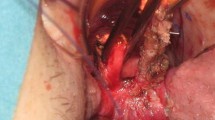Abstract
Background
Persistent anal pain (PAP) after stapled procedures, be it hemorrhoidopexy (PPH) or stapled transanal rectal resection (STARR) may be hardly resolved by medical therapy. The typical objective finding in these patients is the staple line characterized by fixed scar to underlying layers.
Methods
A total of 21 consecutive patients were operated for PAP after stapled procedure. The scarred staple line was excised and detached from layers below, the mucosal continuity reconstructed by single stitches. From January 2003 to December 2013 1500 patients underwent stapled procedure. Of these patients treated in our unit, 9 (0.6 %) were operated for chronic anal pain and 12 were referred to our center from other hospitals.
Results
Fifteen (71.4 %) patients resolved and do not take any drugs for pain; an overall of 85.7 % (18/21) improved their clinical status. Mean time between the beginning of symptoms and the operation was 4.27 months (range 1–18 months). We divided the patients into three groups: before 3 months, between 3 and 6 months and after 6 months from the beginning of symptoms to the operation. The best results were in the first group with 100 % pain relief and satisfactory functional results.
Conclusions
The relief of PAP after stapled procedure, in which we recognize a scarred and fixed staple line, depends by the early recognition of this typical finding. The authors suggest the surgical treatment not later than 3–6 months after the onset of symptoms to achieve the best results.



Similar content being viewed by others
References
Sileri P, Stolfi VM, Franceschilli L, Perrone F, Patrizi L, Gaspari AL (2008) Reintervantions for specific technique-related complications of stapled Haemorrhoidopexy (SH): a critical appraisal. J Gastrointest Surg 12(11):1866–72
Basso L, Pescatori M, La Torre F, Destefano I, Pulvirenti D’Urso A, Infantino A, Amato A (2013) Emerging technologies in coloproctology: results of the Italian society of Colorectal surgery logbook of adverse events. Tech Coloproctol 17:207–211
Brusciano L, Ayabaca SM, Pescatori M, Accarpio GM, Dodi G, Cavallari F, Ravo B, Annibali R (2004) Reinterventions after complicated or failed stapled hemorrhoidopexy. Dis Colon Rectum 47:1846–1851
Ravo B, Amato A, Bianco V, Boccasanta P, Bottini C, Carriero A, Milito G, Dodi G, Mascagni D, Orsini S, Pietroletti R, Ripetti V, Tagariello GB (2002) Complications after stapled hemorrhoidectomy: can they be prevented? Tech Coloproctol 6:83–8
Cheetham MJ, Mortensen NJ, Nystrom PO, Kamm MA, Phillips RK (2000) Persistent pain and faecal urgency after stapled haemorrhoidectomy. Lancet 356:730–3
Peterson S, Jongen J, Schwenk W (2011) Agraffectomy after low rectal stapling procedures for hemorrhoids and rectocele. Tech Coloproctol 15:259–264
Correa-Rovelo JM, Tellez O, Obregòn L, Duque-Lopez X, Miranda-gomez A, Pichardo-Bahena R, Mendez M, Moran S (2003) Prospective study of factors affecting postoperative pain and symptom persistence after staplerd rectal mucosectomy for hemorrhoids: a need for preservation of squamous epithelium. Dis colon Rectum 46(7):955–62
Naldini G, Martellucci J, Moraldi L, Romano N, Rossi M (2009) Is simple mucosal resection really possible? Considerations about histological findings after stapled hemorrhoidopexy. Int J Colorectal Dis 24(5):537–41
Zhao Y, Ding JH, Yin SH, Hou XL, Zhao K (2013) Predictors of early postoperative pain after stapled haemorrhoidopexy. Colorectal Dis 16(6):206–11
Chiarioni G, Asteria C, Whitehed WE (2011) Chronic proctalgia and chronic pelvic pain syndromes: new etiologic insighths and treatment options. World J Gastroenterol 17(40):4447–4455
Martellucci J, Naldini G, Del Popolo G, Carriero A (2012) Sacral nerve modulation in the treatment of chronic pain after pelvic surgery. Colorectal Dis 14(4):502–7
Mari FS, Nigri G, Dall'Oglio A, Cosenza UM, Milillo A, Terrenato I, Pancaldi A, Brescia A (2013) Topical glyceryl trinitrate ointment for pain related to anal hypertonia after stapled hemorrhoidopexy: a randomized controlled trial. Dis Colon Rectum 56:768–73
Thaha MA, Irvine LA, Steele RJ, Campbell KL (2005) Postdefecation pain syndrome after circular stapled anopexy is abolished by oral nifedipine. Br J Surg 92:208–210
Author information
Authors and Affiliations
Corresponding author
Rights and permissions
About this article
Cite this article
Menconi, C., Fabiani, B., Giani, I. et al. Persistent anal and pelvic floor pain after PPH and STARR: surgical management of the fixed scar staple line. Int J Colorectal Dis 31, 41–44 (2016). https://doi.org/10.1007/s00384-015-2355-y
Accepted:
Published:
Issue Date:
DOI: https://doi.org/10.1007/s00384-015-2355-y




